Visiting Tai Hang Sai Estate (大坑西邨), A Historical Place in Hong Kong That Will Be Gone in June 2024
“If you write stuff on the Internet, I beg of you to write about what you have seen here today. Tell the public what’s happening here, and tell them of our plight.” — Mr Hau, a several-decade-long resident of Tai Hang Sai Estate
Ok, Mr Hau. This blog post is for you.
Tai Hang Sai Estate is a housing estate in Hong Kong that once housed around 1700 households. The whole estate is scheduled to be vacated in March 2024 to be taken down and rebuilt.
An average private housing estate in Hong Kong looks like this:

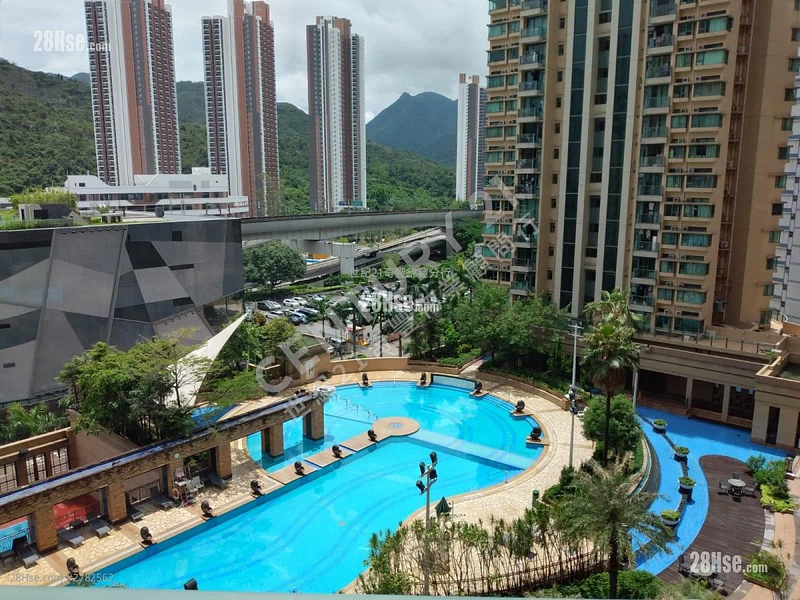
An average public housing estate in Hong Kong looks like this:
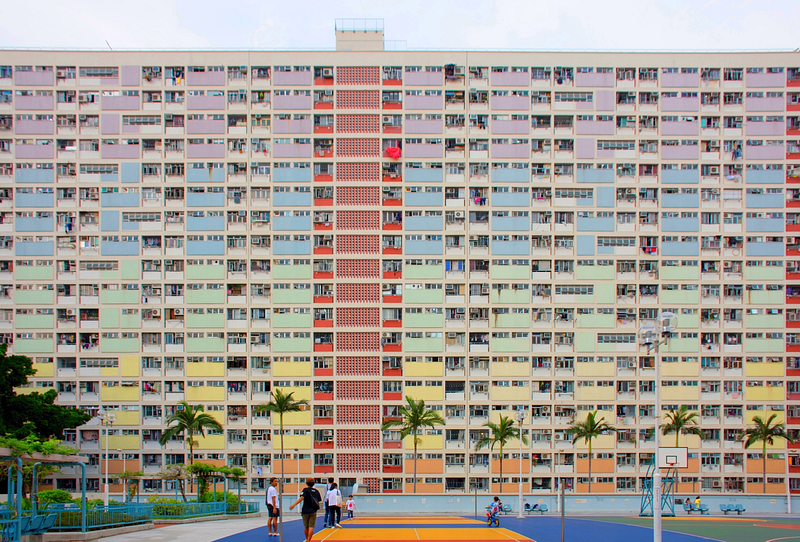

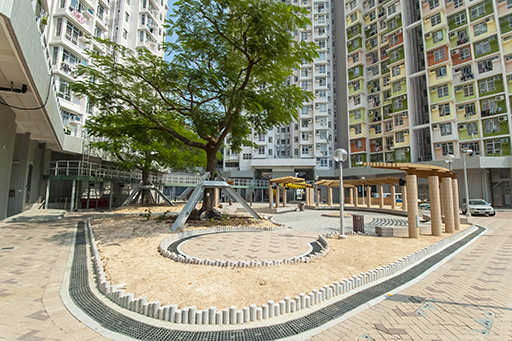
And this is what Tai Hang Sai Estate looks like:
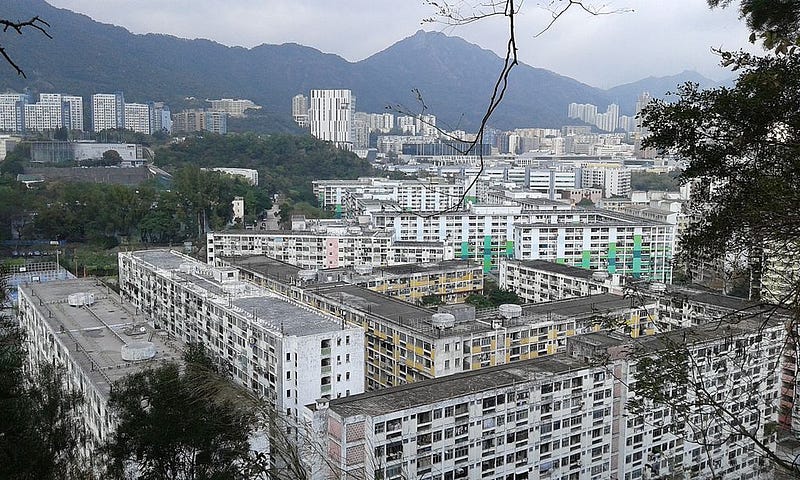

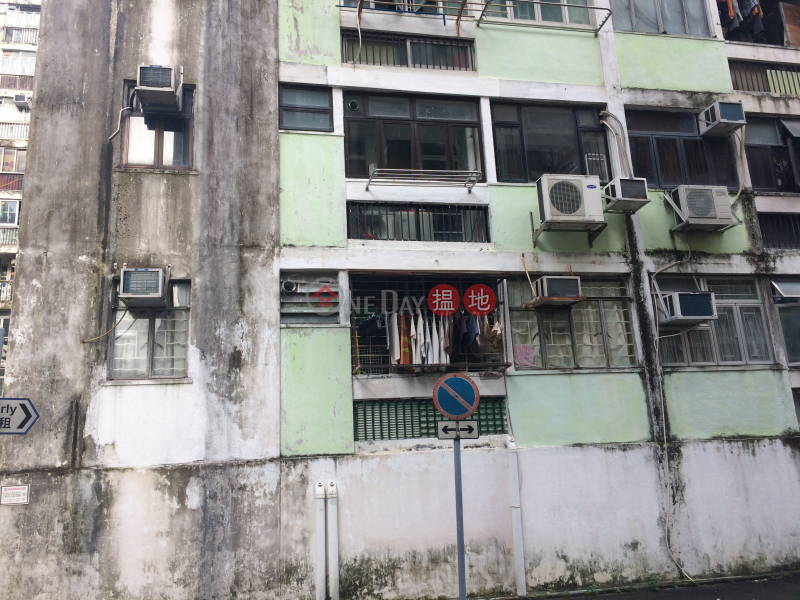
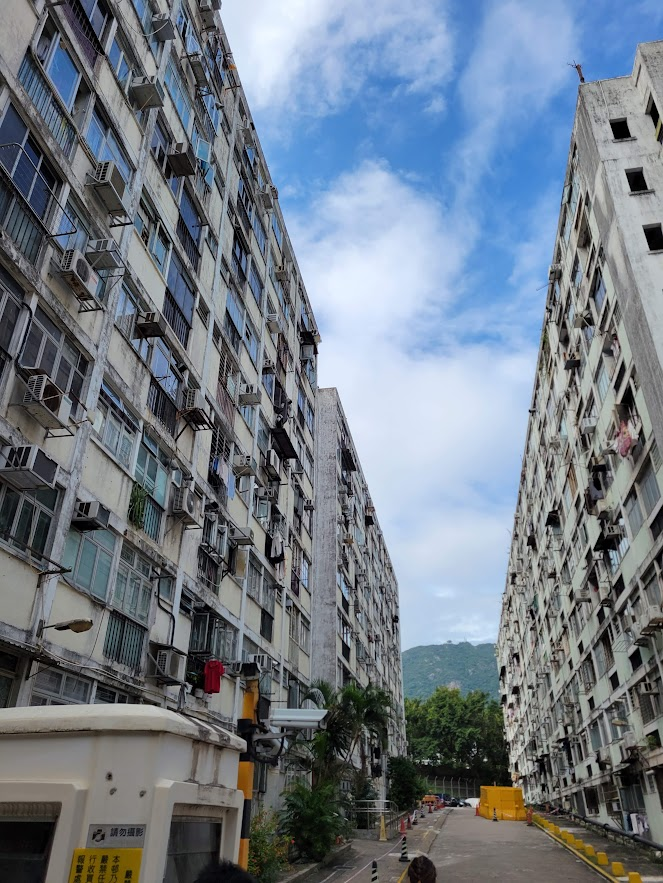

… which looks pretty shabby and like it obviously needs maintenance, considering that it is a housing estate with eight blocks (and not the average slum-like singular buildings in Hong Kong with “subdivided homes” or “cages” that often appear on international news).
On 22 October 2023, I joined a guided tour of this estate held by Lonely Paisley and Tai Hang Sai Estate Resident Right Concern Group. During the tour, I learned about how this housing estate for the underprivileged was somehow privately owned and ended up in this shambled state, and chuckled at some moments as the two impromptu tour guides “guided” us to different parts of the estate that will most probably be gone next year.
The first thing that caught our eyes when we walked into the estate were the posters and slogans written on banners, old shirts, and old comforters. The Chinese character spray-painted repeatedly on the shirt means “miserable”. The slogans of the banners are all different complaints about the government and the housing estate management neglected and even proceeded maliciously with plans of demolition and redevelopment.

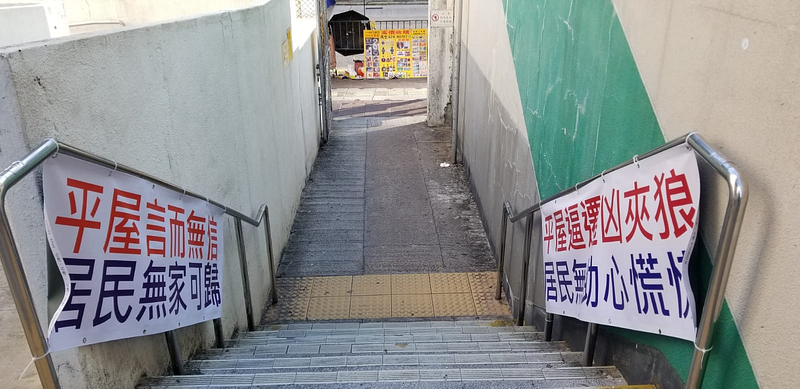
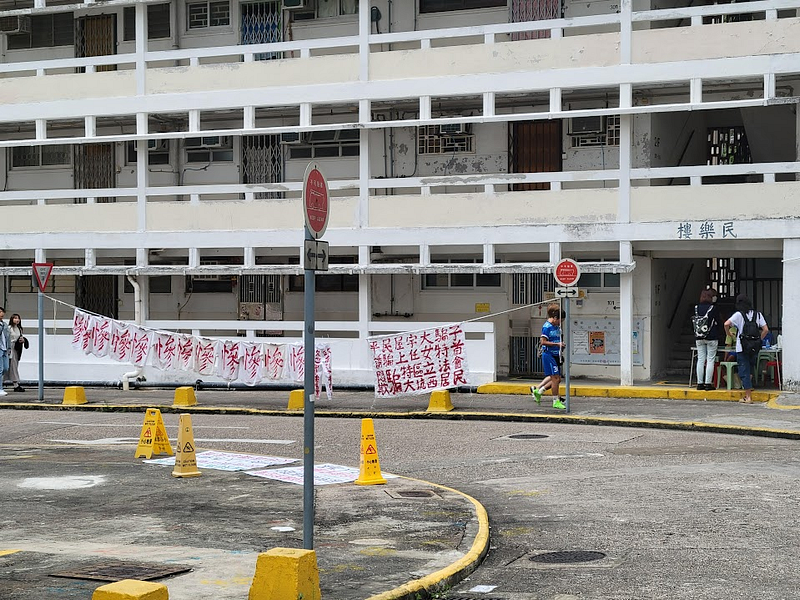
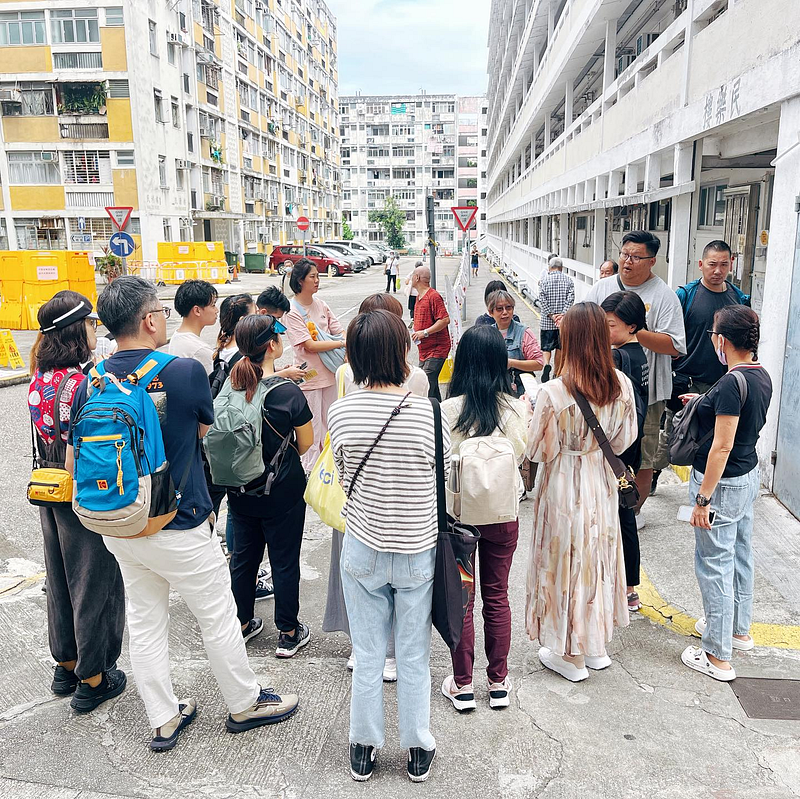
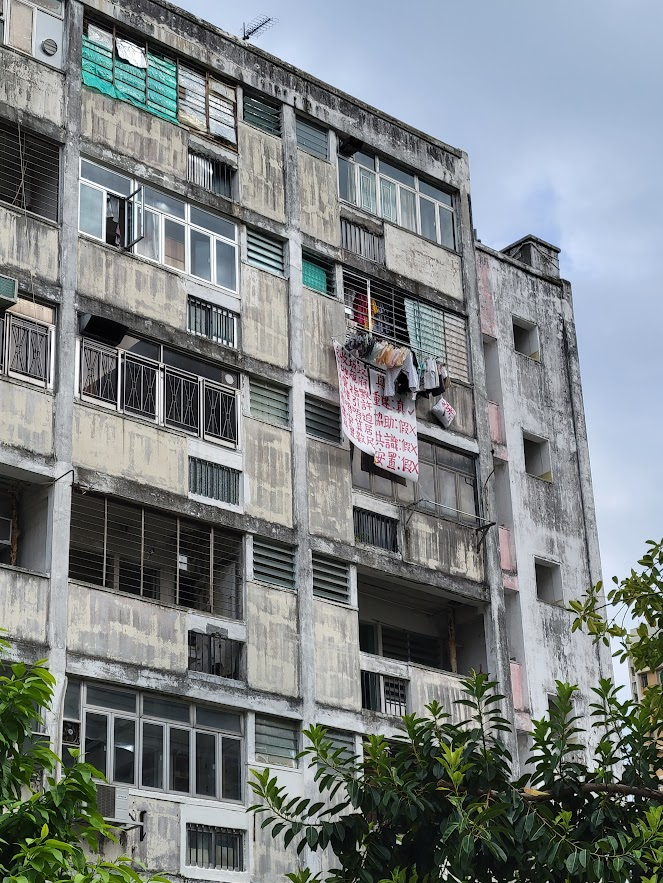
All of us could quickly tell that tour guides were not trained in any way and that there would be two main people speaking during the tour — a woman who is probably the resident representative of the whole thing, and a guy who is probably a social worker and has been helping the residents to voice their needs. We were given a booklet printed in 2021, which explained the history of the estate and the whole redevelopment ordeal.
A Real Quick Brief Intro to History of Tai Hang Sai Estate
- A bunch of people used to build wooden houses and lived in them. In 1953, a huge fire happened in the Shek Kip Mei wooden house area. The fire was nearly 30,000 square meters big. 58,000 people became homeless overnight. This fire was the main reason why the government started building public housing, so it was a historical event taught in primary school. It horrifies me to find out that the fire happened on a Christmas night while writing this paragraph.
- The first kind of public housing built by the government was called “Resettlement Estate”. Living quality of the estates: everyone on the same floor shared one common kitchen area and one toilet area. Not ideal.
- The modern version we have now is called “Public Rental Housing Estates”. Living quality of the estates: each flat has its kitchen and toilet inside. More ideal.
- During the times between having the Resettlement Estates and Public Rental Housing Estates, the government probably didn’t have enough money for… stuff. And probably a bunch of people had the money and wanted to be developers. So the government was like, fine. If you’d like to buy some land, you must build housing that can only be rented by low-income people on the land you bought. We will sell the land to you at one-fifth of the market price and lend you 10 million dollars to build the thing. No other requirements.
- A bunch of rich people formed “Hong Kong Settlers Housing Corporation Limited”, took the deal, built Tai Hang Sai Estate (and a few other ones), and have been managing the estate till now.
- Tai Hang Sai Estate was built before any Public Rental Housing Estates, and each flat in Tai Hang Sai Estate has its own kitchen and toilet. Extremely ideal back then.
- All public housing in Hong Kong is managed by two main government things — Hong Kong Housing Authority and Hong Kong Housing Society. Hong Kong Settlers Housing Corporation is not a government thing, and is still a private company. Government things needed to meet new government requirements for public housing, while private companies… don’t. So they just… don’t. All public housing rental estates have elevators these days; the buildings in Tai Hang Sai Estate are 8 stories high and still, there are only stairs.
- In 2010, Hong Kong Settlers Housing Corporations applied to redevelop the Tai Hang Sai Estate area, and if I remember correctly, the residents were not notified or consulted when the company did that.
- The residents thought that the company’s plan of relocating residents during the redevelopment sucked. The company thought that the residents’ disagreement sucked. The government was like, if the residents don’t like what you do, our hands are tied and you can’t redevelop according to your plan.
- The company applied to delay the redevelopment plan to June 2024, and the government ok-ed it, and the company said all residents must leave in March.
Why did we notice that our two tour guides were not trained? By the fact that all participants were stuck at the entrance of the estate listening to the tour guides ramble on about what I have just said above for a good 15 minutes (maybe 30??), with zero indication of which part of the privately subsidized rental estate we would visit next.
The woman resident, who has been living in the estate for at least two decades, needed to recall the names of the eight buildings in the estate using a piece of gray cardboard that she had probably cut off from a biscuit box and scribbled on. The woman is at least 70 years old. My friends and I signed up for the guided tour expecting it to be a spontaneous and down-to-earth history tour. We were fine with what the woman was doing.
We finally got to walk to another spot — the oldest block of the entire estate.
“These two trees have been around for decades and we saw them grow from small trees…” The woman went on, her voice fading from half of the tour participants because she was walking too fast.
“She has been living here for decades and did not know what species the trees are,” my friend whispered. “Well most people can’t identify the trees in their neighborhood, and we only knew because we are nerds — ”
The woman’s voice suddenly boomed across the estate, cutting me off. “Hey so we’ve finally got a wireless mic from one of our neighbors.” We looked up to see that a random man, holding a portable speaker, had appeared out of nowhere and joined the tour.

This close-knitted community vibe carried on until the very end of the whole tour.
All the shops of the estate are located in the oldest block, and by all the shops I meant 6–7 retail spaces available in a dimly lit building. Only three shops were open when we visited. The only reason the tour took the directions to the shop was because one of my friends yelled, “Why is there a tutorial center in the middle of a housing estate filled with elderly people?”
“This store space was once a stationery shop long long ago,” one of the ladies in the tour group who turned out to be a resident suddenly added. We could see that — the tutorial center didn’t even bother to remove the sign from the old shop. I think that’s somehow a good thing because they accidentally preserved a piece of history.

My friends and I all used to teach for a living, so during this informative tour about cultural conservation and urban planning, we were appropriately paying attention to the tutoring rates plastered all over the storefront.
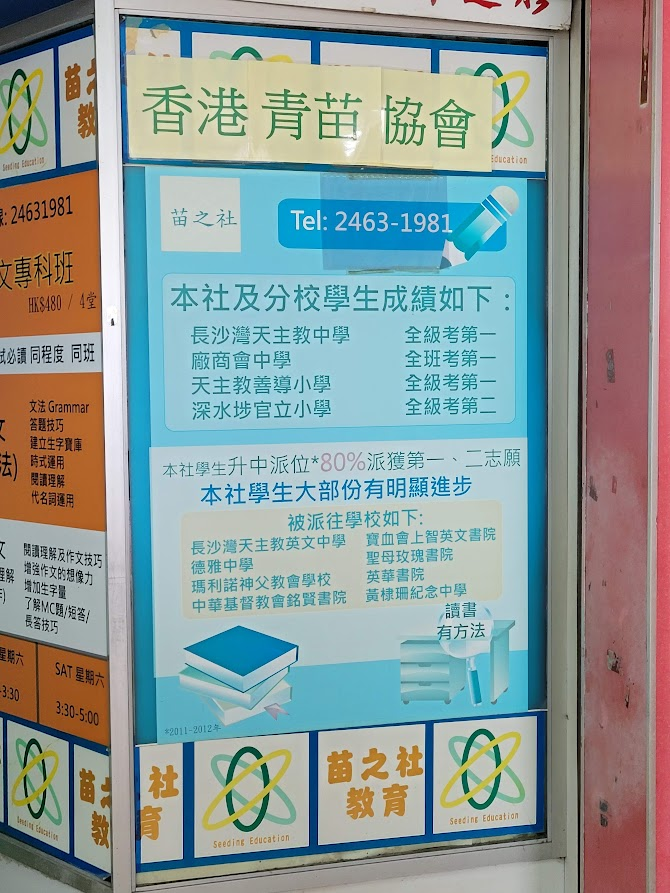
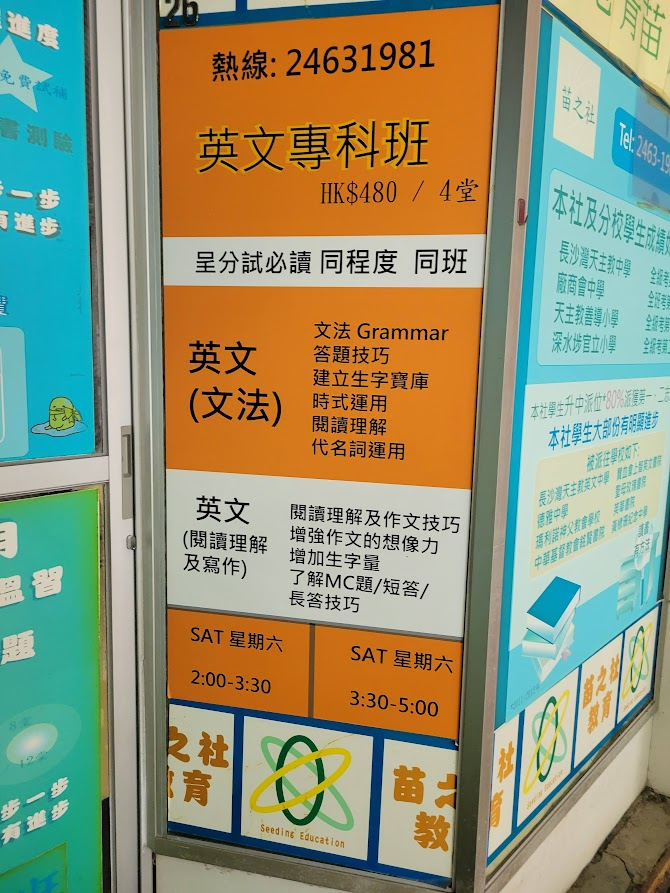
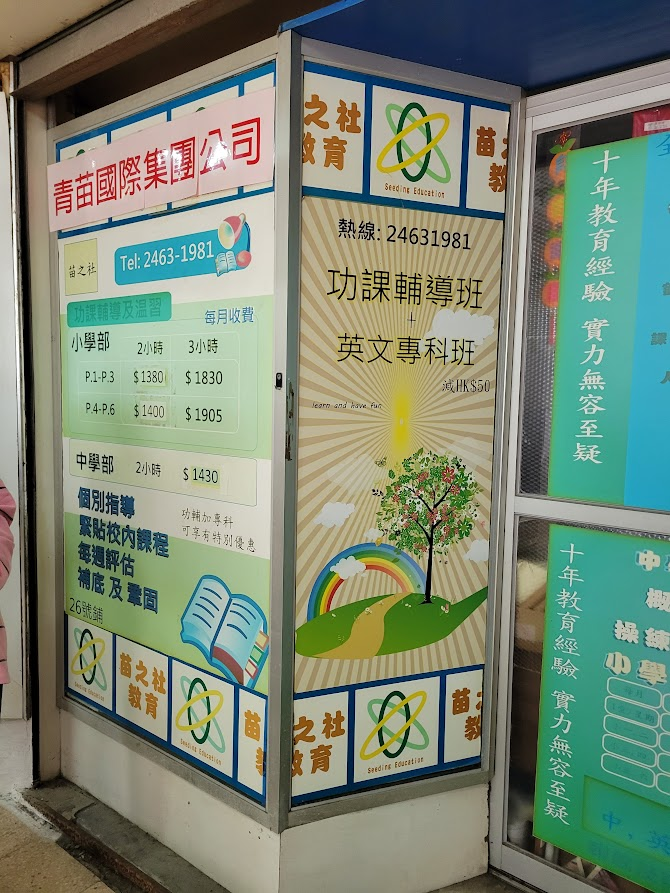
The whole group walked along the corridor as several more random residents joined the tour after hearing the commotion. They added here and there that there used to be a Costco among the shops. There’s no one selling food now though.
A historical hair salon was located near to the tutorial center.
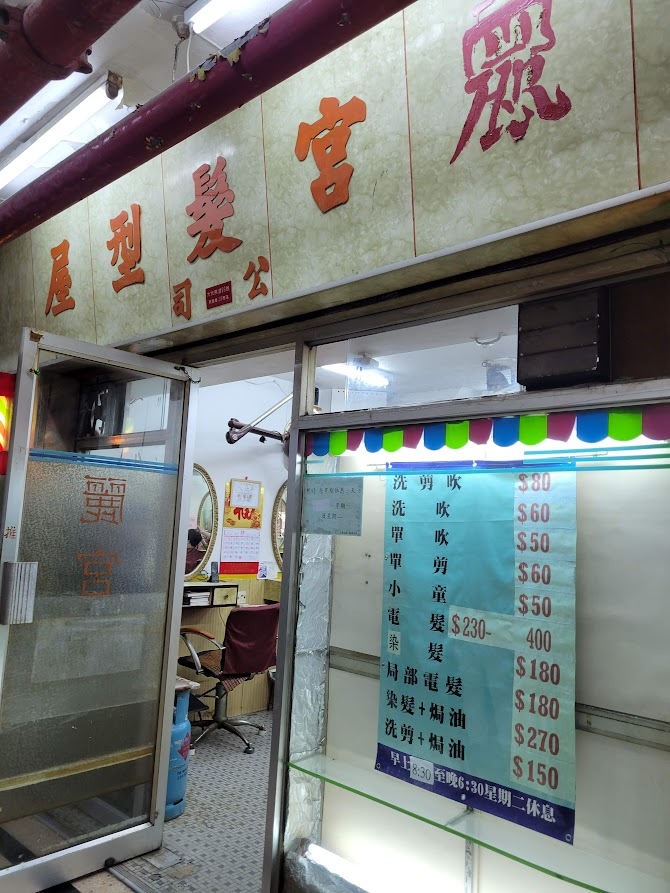
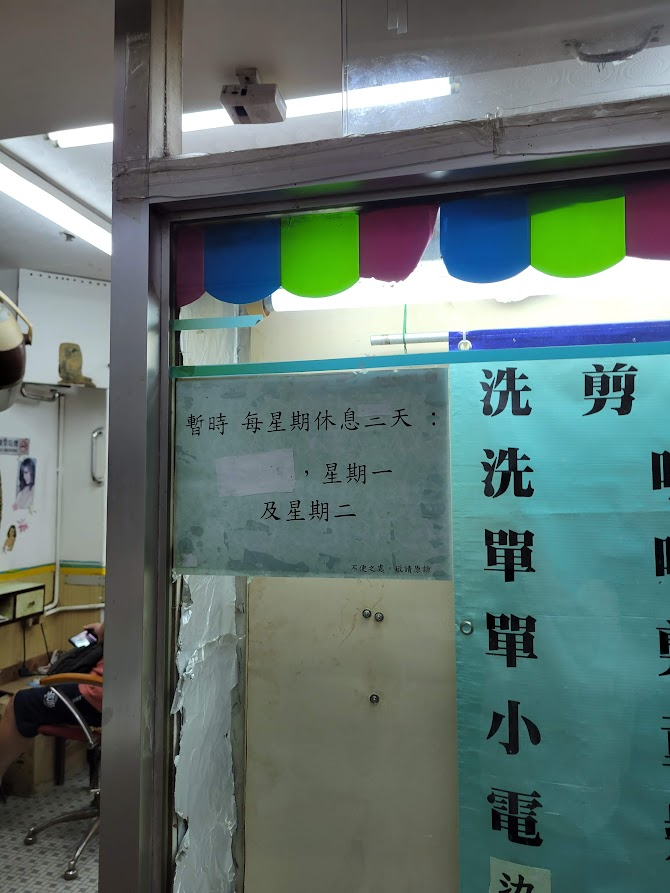

There was also a 43-year-old optometrist’s shop with olden neon lights as the shop sign and several other shops that were closed when we visited.
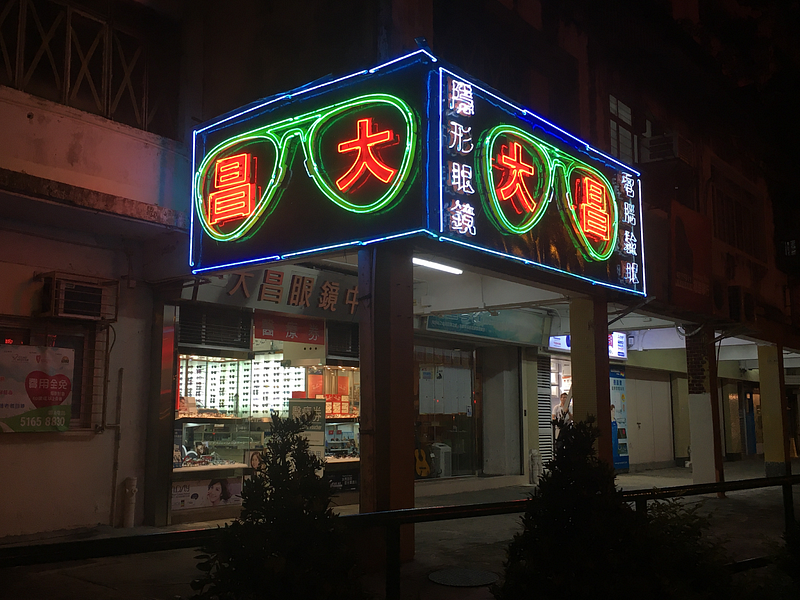
Between all of the old, shabby shops, there was a modern, sleek door with an electronic passcode lock. A shiny metal sign outside the door says “Hong Kong Settlers Housing Corporations — Office for Signing Lease Termination Agreements”. There was also a newly installed steel mailbox for people to “put their signed lease termination agreement in”. That’s the only reason why the company set up a physical office — for the residents to accept the redevelopment arrangement and move away. The entire setting silently screams the tension between the old and new.
The residents told us how there used to be a huge Chinese yum cha place that spanned two floors. They then led us out to the estate’s official entrance — a set of staircases that led to a small gate that only 6–7 people could squeeze through. “All the other entrances are only open from 6 am to 1 am,” the woman explained, “For other times, you must pass through the security guards at this gate to get in.”

It was weirdly heartwarming to experience something so uncurated and sincere; the fact that the woman struggled to organize and express her thoughts with a booming microphone made my friends and I smile the whole time.
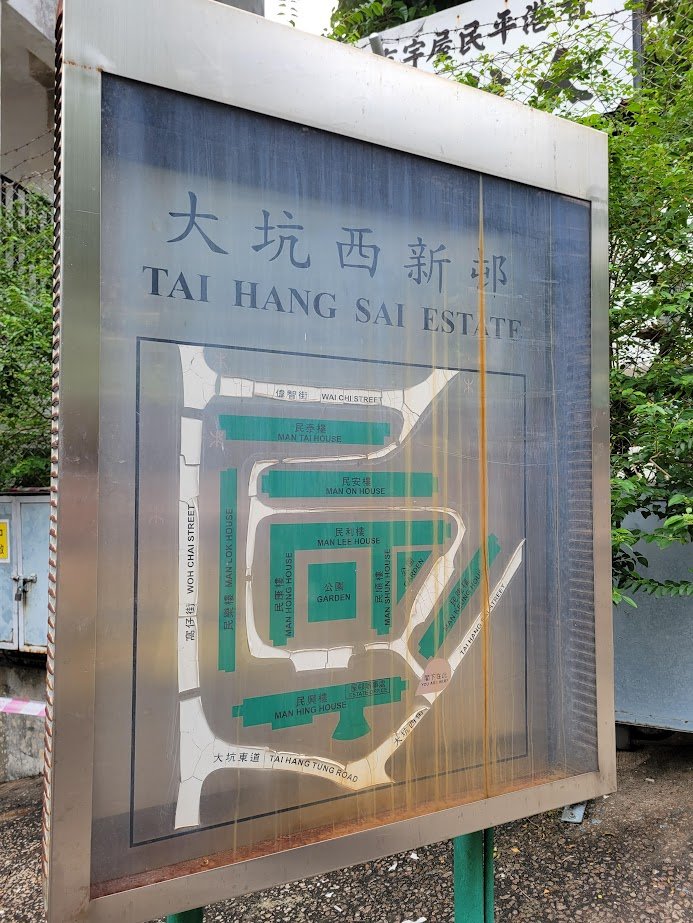

We stopped in a hallway and the woman stopped using the mic. The social worker guy started a 30-minute long speech about how it was impossible to get a hold of a single person of the management company, how sending in petition letters after talking to the media felt like “burning them to send to an ancestor” because there would never be anyone receiving it, and how the residents received vague threats whenever they hang up banners and call the police to handle noise issues caused by construction and surveying work from the management company. During the speech, I took photos of the hallways where the flats are, and were really concerned about how dim and therefore dangerous they can be.

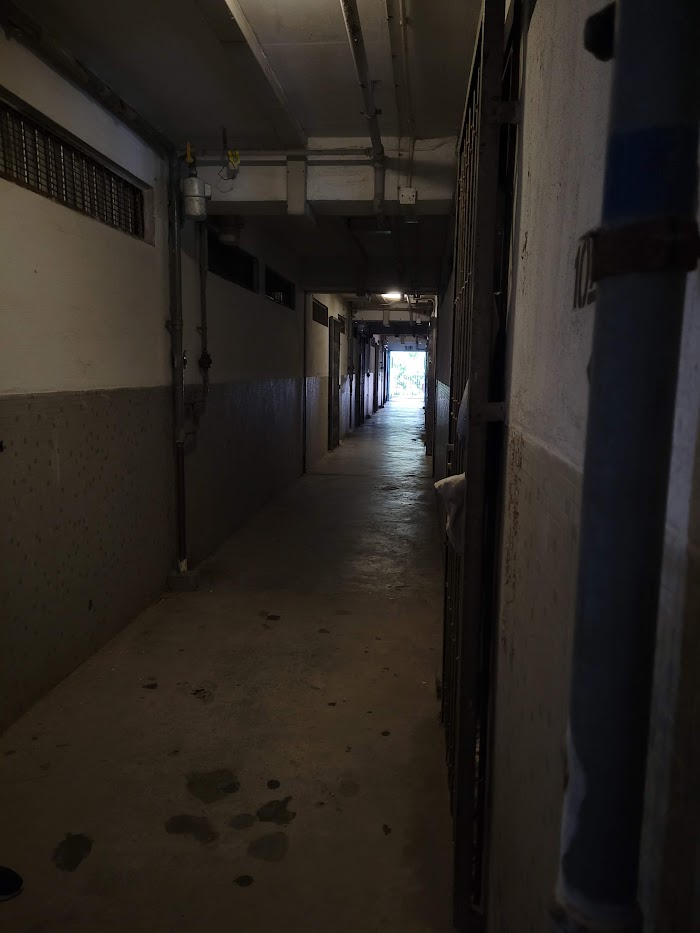
The social worker guy gestured us to look at a notice board, where the company had posted an extremely formal notice notifying all residents that they must move away in March. Given that it’s impossible to start a conversation with the company, the concern group wrote and put “a reply to the notice” on the same notice board. It’s clear that the communication between the two parties has reached a stalemate, and the company is not exactly motivated to talk to the residents either.
Some more key information that the woman and the guy told us during the speech
- The management company offered a sum of money for those who are willing to move away during the redevelopment; the sum of money was for them to rent a place somewhere else. A resident (not the woman) said that the amount of money was certainly not enough for them to rent a (proper) flat nearby
- The company promised if the residents went through their screening process and are proved eligible, they can move back
- The majority of the residents who are still living here are at least 70 years old, and many of them live alone. A lot of them just didn’t want to move out at all
- The residents want the company and the government to let them stay at one of the public renting housing estates for a while instead of getting the money and having to arrange things by themselves
All this talking and we still didn’t know the names of the woman and the guy. They didn’t introduce themselves.
The organizer of the guided tour reminded the woman and the guy that time was running out. So the whole group hurried to the last block that was built in the estate (the eighth block) to see what walking up to the top of the building felt like.
Right before we headed into the block, an old man with a walking stick somehow took the mic and said he was a resident who would like to give his two cents about the whole ordeal — once he started talking, it was obvious that he should have been the resident leading the whole tour instead. I was surprised by his eloquence and the English words he used (“compensation”, “relocation”, “agreement”, “termination” etc) in between what he was saying in Cantonese.
“I used to live on one of the high floors, but I was able to apply to move to a flat on the ground floor after my leg injury,” he said. “I heard that you’re all going up the flight of stairs to the eighth floor. If any of you would prefer to stay on the ground floor with me, I can tell you my story in this estate.”
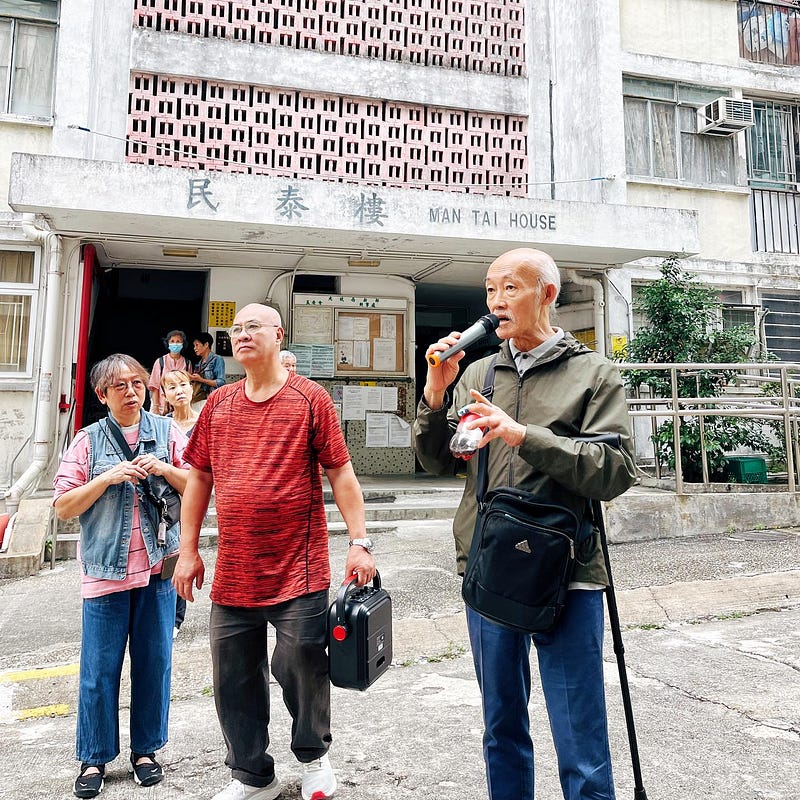
We later learned that the man is Mr. Hau, the one who said the first line of this very blog post. But Mr. Hau said he would wait for us and we could always talk later, so the whole group went up the stairs.
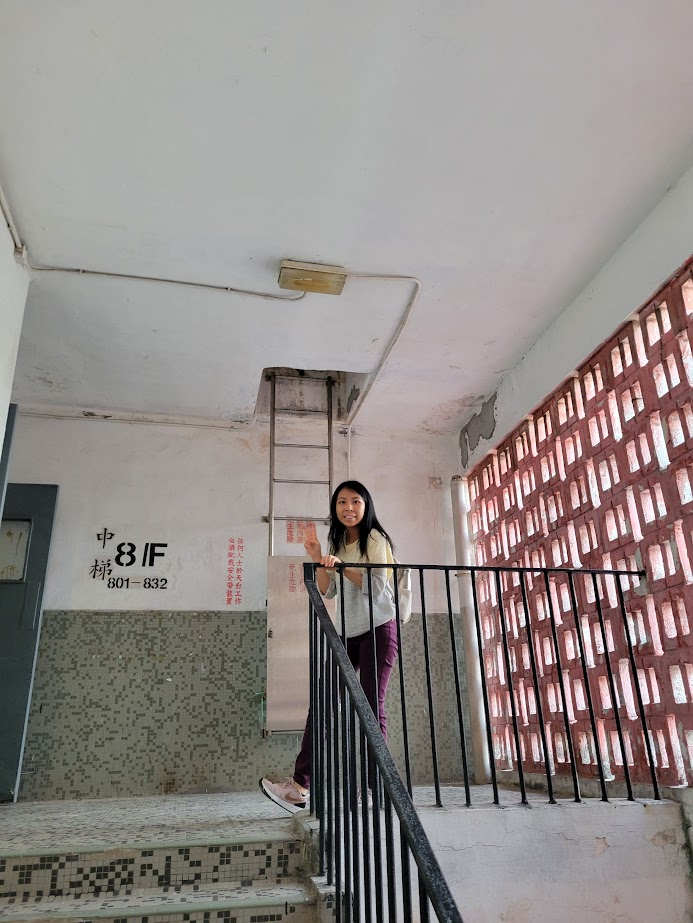
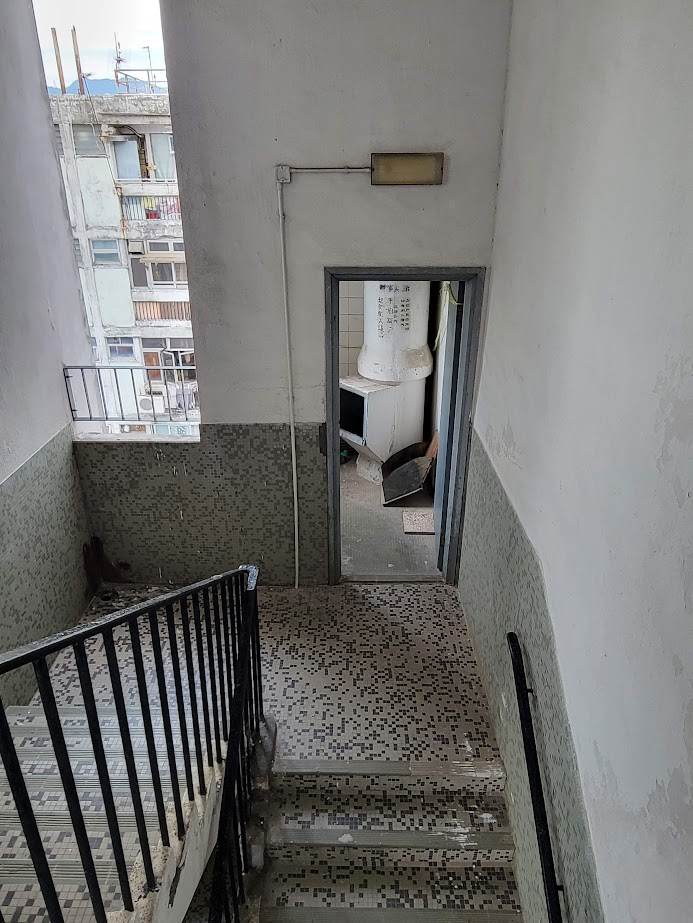
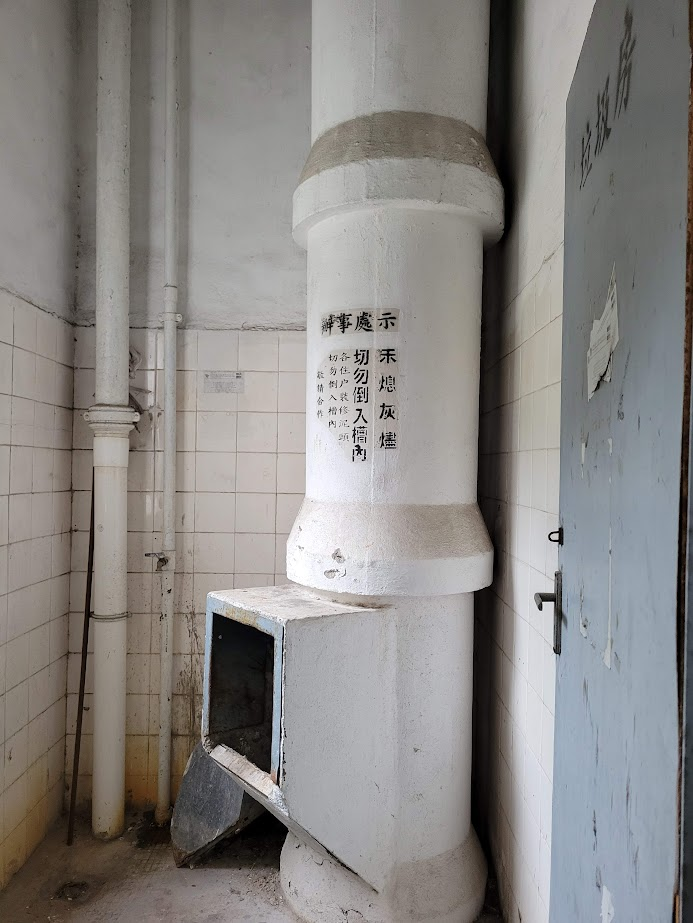


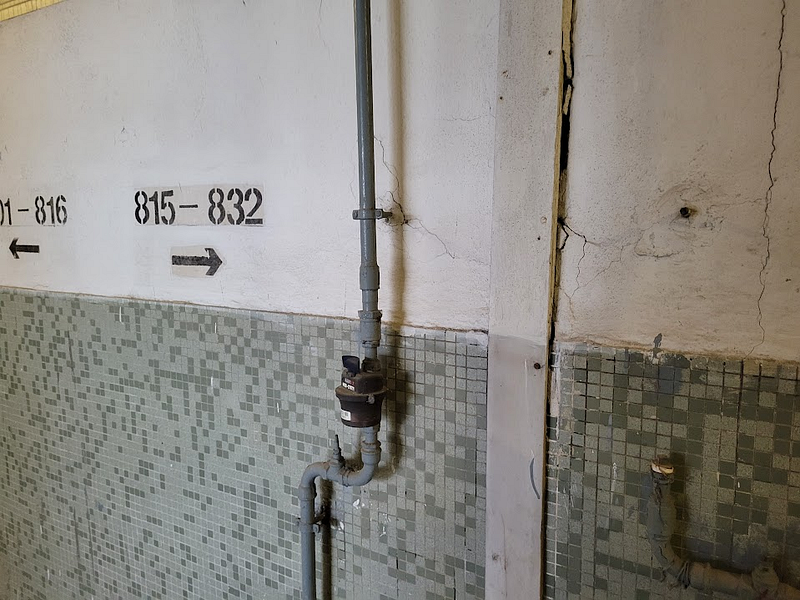

The woman said she once learned from some paramedics that whenever an ambulance was called, the fire stations near the estate follow a roster that was set up just for this estate to take turns to come because there are no elevators for the 8-story high buildings here. Every time the paramedics come here, they might have to carry a gurney 8 stories up.
We headed back down, the tour guides wrapped up and announced it was the end of the tour, asked us to join a Facebook group set up by the concern group, and the woman finally told us she was called Ms Au Yeung and that she had been one of the faces of the concern group.
I stayed for a bit to talk to Mr Hau. Mainly I was genuinely curious about the story of him moving here and how he seemed to be much more knowledgeable than other residents present.

“The reason why my family was assigned a flat here was because my father and I used to be employees of Hong Kong Settlers Housing Corporation. We were both auditors and I used to do auditing work with an abacus.”
He told me about the rent and moving problem again and explained to me how the company has been extremely vague about who can get a new flat once the estate has been redeveloped.
“Please help us tell the public that we want two things — a place to stay, for certain, during the redevelopment; and a place to live after.”
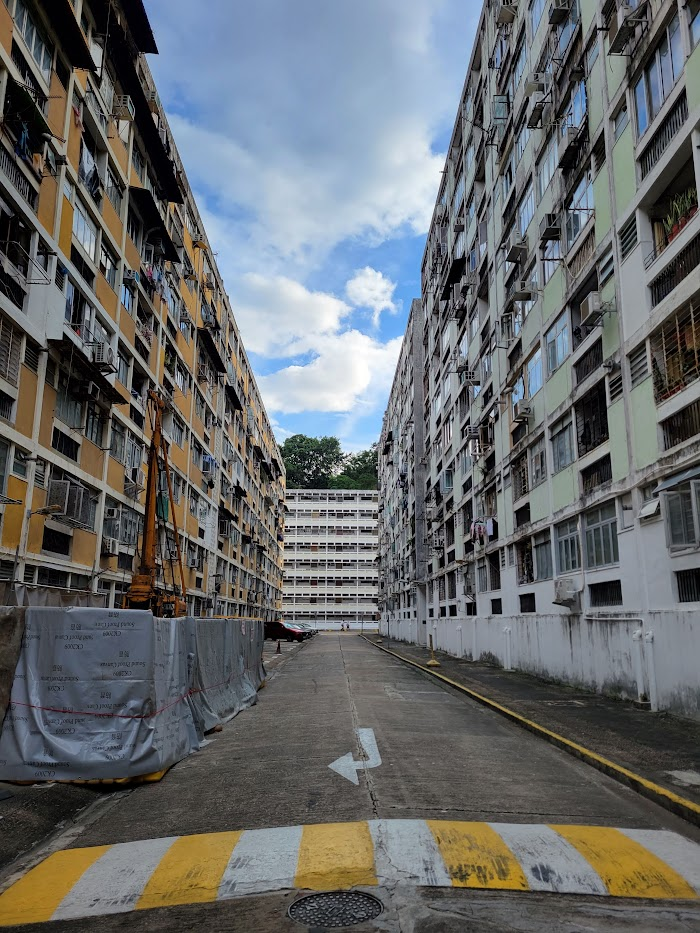
It started raining so we left.
Conclusion of The Whole Tour (The Bit that Actually Matters)
- I read a few in-depth reports about other residents in the housing estate when I got home, and boy were they depressing. In 2010, an elderly couple died in one of the flats and their bodies were only discovered three days later because of the stench. There is a 72-year-old woman taking care of her 102-year-old mother stuck on the 6th floor; a 91-year-old man stuck on the 3rd floor — no one would rent any flats to these people in need. I only truly understand the severity of the situation after reading about these stories. I hope these people will be given places to stay during the final years of their lives.
- Hosting guided tours is a good way to raise public awareness over an urban planning social issue — before this tour, I didn’t even know that there’s a place called Tai Hang Sai Estate. But if the content of the tour was not planned, the only takeaway for the participants of the tour would be the vibe of the neighborhood and… nothing else. I don’t think it’s a good way to get people to stay informed.
- Tai Hang Sai Estate is an important piece of Hong Kong history and I hope some parts of the building will be conserved so that people can learn the old ways of life later.
- More guided tours of the estate will be held before the evacuation. You can join them here and here.
You’re gonna miss me by my hair; you’re gonna miss me everywhere. You’re gonna miss me — when I’m gone.
Not if you click this link below and get an email notification when my next post is up:
https://thatshirleylee.medium.com/subscribe
Buy me a coffee / Support me monthly here:
